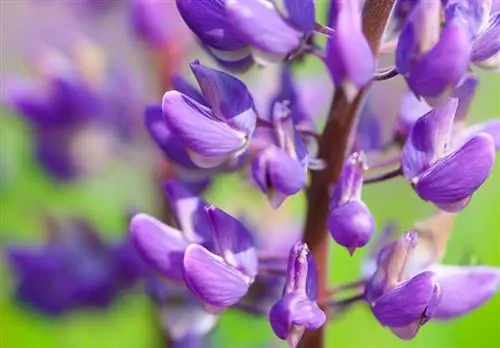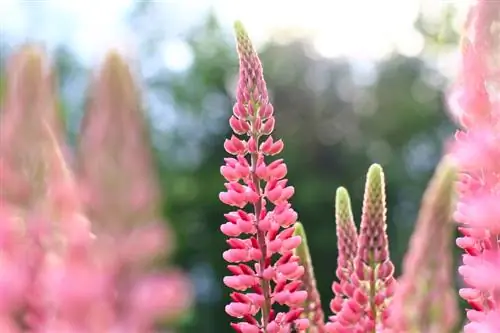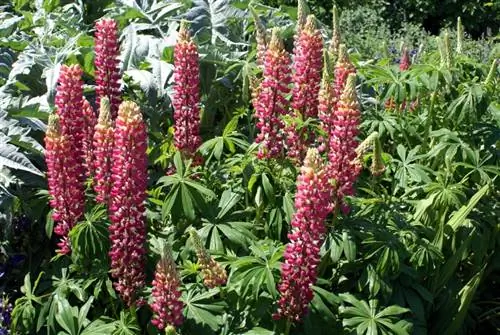- Author admin [email protected].
- Public 2024-01-10 23:11.
- Last modified 2025-01-23 11:22.
Lupins combine rural charm with sublime elegance. The versatile summer flowers decorate the garden with their colorful flower candles and serve as fodder, green manure and vegetable plants. Are you wondering how to properly cultivate this miraculous flower? Then read all the elementary answers here.

How do I properly care for lupins in the garden?
Lupins are easy-care flowers that thrive in sunny to partially shaded locations with deep, humus-rich and slightly sandy soil. They need regular watering, occasional cleaning of the flowers and, if necessary, compost fertilization (also liquid fertilizer in the pot) for optimal growth and flowering.
Planting lupines correctly
Planting time for young lupines grown by hand or purchased ready-made begins in mid-May after the Ice Saints. While preparing the soil, soak the flower's potted root ball in a container of water. Follow these steps to get started:
- Create a planting pit with twice the volume of the root ball
- Spread drainage on the sole made of grit or pottery shards
- Plant the potted flower, press the soil and water
- Place more lupins 40-50 centimeters apart
The lupine also cuts a fine figure in a large bucket with a volume of more than 20 liters. Use commercial potting soil as a substrate, mixed with a handful of sand. Don't forget to install the essential drainage above the water drain in the bottom of the pot to protect against dangerous waterlogging. A water- and air-permeable fleece prevents soil crumbs from getting stuck between the inorganic material and clogging it.read more
Care tips
As a prime example of an easy-care flower, the lupine is completely satisfied with the following measures:
- Water regularly in the first year
- Weed every few days until the lupine is established
- From the second year onwards, only water the flower when the summer is dry
- Always water lupins in planters when the substrate dries
- Clean out from time to time during the flowering period to make room for fresh flowers
- Instead of mineral fertilization, add a portion of compost every 4-6 weeks
The flower does not want to be mulched with leaves or grass clippings. The lupine has no objection to a thin layer of gravel or grit. The butterflies supply themselves with nutrients by the deep taproots absorbing the nitrogen and phosphorus present in the soil.
Which location is suitable?
The Lupine not only scores points with its multifaceted talents, but also impresses with its frugal demands on the location. In order for the majestic flower to unfold its beauty to perfection, this position is important:
- Sunny to partially shaded with at least 4 hours of sunshine per day
- Warm and protected from the wind
- Deep, humus-rich soil, fresh and slightly sandy
- Ideally with a pH value between 4.5 and 6.5
- No other lupins in the previous 4-5 years at the location
The opulent flower feels at home along a sunny edge of trees or a hedge. Above all, lupins do not want to be confronted with waterlogging or extreme dryness.read more
When is flowering time?
The lupine owes its popularity not least to its never-ending flowering period from May until well into August. Regular cleaning and light pruning after the first flowering extends the flowering period until late summer.read more
Cut lupine correctly
With targeted pruning at the right time, the chances of re-blooming in late summer increase. After flowering, cut the flower back to 10 centimeters. In this way, enough buds remain on a lupine from which it can sprout again. Shortly before the first frost, trim the plant to a hand's width above the ground or make the cut in early spring.
If the clippings contain legumes, they will not be disposed of in the compost. The risk of unsuspecting animals becoming poisoned by the grains is too great.read more
Fertilize lupine properly
The lupine is one of the best plants for green manure. The flower enriches the soil with nitrogen, makes phosphorus more accessible and loosens even compacted soil with its powerful taproots. As a previous crop, lupins pave the way for other plants to grow vigorously.read more
Propagate lupins
One of the many uncomplicated characteristics of a lupine is that it is very easy to propagate. To do this, dig up the rootstock of an established flower in March or April. Use a sharp knife or spade to divide the bale into several segments. Each section should have at least 2 buds. Plant the rejuvenated lupins again in a suitable location.
With cuttings, breeding can also be done in no time during the summer. Suitable shoots are 10-15 centimeters long. After the lower half has been defoliated, place each cutting in a nursery pot with lean substrate. At a warm 20-25 degrees in a bright place, rooting takes place quickly.read more
Lupine in a pot
A variety of enchanting lupine varieties are ideal for cultivation in pots. In order for the flower to develop well in the limited substrate volume, the following aspects are important:
- Water regularly when the substrate surface has dried
- Give a dose of diluted liquid fertilizer every 4-6 weeks
- Cut back to the ground before winter
- Protect the root ball in the pot from frost with fleece or bubble wrap
read more
Is lupine poisonous?
Lupins contain toxic alkaloids, which are also known as bitter substances because of their taste. Eating lupine grains in particular causes symptoms of poisoning, such as vomiting or cramps. Due to the unpleasant taste, people rarely ingest harmful amounts of plant parts of this flower. However, garden lupins pose a danger to animals. Horses, pigs, cows, dogs, cats and rabbits are affected.
It has been possible to almost completely remove the bitter substances from special lupine varieties. That's why this flower is now finding its way into the vegetable garden under the name sweet lupine and is grown as a fodder plant because the grains of its legumes are rich in he althy proteins.
The perennial lupine
The lupine is one of the deciduous perennials. This characteristic implies that the flower sheds all its leaves before the first frost. The withered stems can then be cut off close to the ground. The root ball overwinteres in the ground to sprout again in the next season.read more
The lupine in the garden
Caring for a garden lupine requires only a small amount of horticultural attention. The natural rainfall covers the water requirement from the second year onwards. The watering can is only used in summer droughts. With its long taproots, the flower automatically gets all the important nutrients from the soil, so fertilizer is unnecessary. A pruning after flowering attracts further flowering.read more
Growing lupins
For growing lupins in your green kingdom, you have the choice between two different methods. Direct sowing of the robust seeds is possible from mid-March. The sowing depth is 2-3 centimeters, at a distance of 40-50 centimeters. At a temperature of 4-6 degrees Celsius, germination begins within 7 days. Daily weeding and regular watering are the top priority for a successful culture.
In order to avoid the unpredictability of sowing, hobby gardeners prefer to plant an early flower. Once the ice saints have passed by in mid-May, place the lupine, previously soaked in water, in the loose, permeable soil in a sunny location. The administration of fertilizer of any kind can be dispensed with, while an adequate supply of water is the be-all and end-all of care in the first few weeks.read more
Sowing lupins
Since blue lupins can tolerate down to -8 degrees Celsius after sowing and white or yellow species can still tolerate -4 degrees, early direct sowing is an option. Since a minimum temperature of 4-6 degrees Celsius is required for germination, the time window for sowing opens in mid/late March. There is another date to sow lupins in August. How to do it right:
- Prepare the seedbed with fine crumbs and looseness
- Insert the seeds 2-3 centimeters deep at a distance of 40 centimeters
- Press the soil lightly and water with a fine spray
- A garden fleece protects against unexpected ground frosts, a net protects against pecking birds
Germination begins after a few days. Keep the seedbed constantly slightly moist and free of weeds. Alternatively, sow the seeds in peat pots on the partially shaded windowsill or in the greenhouse. As a substrate, we recommend a nutrient-poor peat-sand mixture or commercially available seed soil. This form of cultivation is possible all year round.read more
Is the lupine perennial?
Once settled in the bed, the lupine will delight you every year with its flower festival. The herbaceous flower retreats into its frost-resistant root ball throughout the winter. In early spring the young shoots appear, from which the flower candles quickly develop.read more
Is the lupine hardy?
The lupine is one of the hardy perennials. This means that it pulls in its above-ground plant parts before winter in order to happily sprout again next year. You can safely do without protection from frost and snow. The flower only needs suitable precautions against frosty temperatures in the year of sowing or planting and in the pot.read more
The most beautiful varieties
- Noble boy: a magnificent lupine with crimson flares
- Miss: creamy white flowers all summer long
- Chandelier: this yellow lupine lives up to its name
- Kastellan: blue beacon at a height of up to 100 centimeters
- Castlewoman: pink beauty whose foliage turns yellow after flowering
- Masterpiece: the ideal variety for vase decoration thanks to the violet-blue flower cluster
- Towering Inferno: flaming red garden lupine with remarkable winter hardiness
- Beefeater: impresses with its slim silhouette and bright red flower candles
- Nanus Gallery Yellow: the dwarf lupine for small gardens and pots
The yellow lupine
Like no other lupine within the diverse plant genus, the yellow lupine is predestined for a sandy location with acidic soil. In general, this flower requires the least amount of care and thrives even when left to its own devices. The other side of the coin, however, is their high susceptibility to the plant disease anthracnose. With varieties such as Bornal or Desert Sun you can avoid this shortcoming.read more






